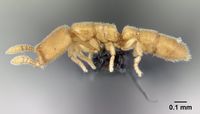Prionopelta laurae
| Prionopelta laurae | |
|---|---|

| |
| Scientific classification | |
| Kingdom: | Animalia |
| Phylum: | Arthropoda |
| Class: | Insecta |
| Order: | Hymenoptera |
| Family: | Formicidae |
| Subfamily: | Amblyoponinae |
| Tribe: | Amblyoponini |
| Genus: | Prionopelta |
| Species: | P. laurae |
| Binomial name | |
| Prionopelta laurae Overson & Fisher, 2015 | |
This species has been collected in leaf litter primarily in rainforest with some collections from littoral rainforest and one in tropical dry rainforest, at elevations between 10–600 meters. Its range is restricted to eastern Madagascar and is seemingly disjunct, with most individuals collected from the northeast and only two locales known from the southeast near the coast. No individuals have been collected between Sahafina Forest in the north and Mahabo forest in the south, a distance of 500 km. The current range of P. laurae is such that it may once have been distributed along the entire eastern coast of Madagascar. (Overson and Fisher 2015)
Identification
Overson and Fisher (2015) - P. laurae is the only Malagasy Prionopelta with workers that possess nine antennal segments (all others possess twelve). Additionally, it is the smallest of all the Malagasy species with HL < 0.4 mm and HW < 0.3 mm (HL and HW of all other species is greater than 0.4 mm and 0.3 mm respectively).
This species of Prionopelta is unmistakable as it is the only Malagasy species with nine antennal segments. It is also the smallest known species of Malagasy Prionopelta and is a distinct pale yellow color, which is much lighter than the fully-sclerotized workers of any other Malagasy species.
Keys including this Species
Distribution
Latitudinal Distribution Pattern
Latitudinal Range: -13.255° to -24.7717°.
| North Temperate |
North Subtropical |
Tropical | South Subtropical |
South Temperate |
- Source: AntMaps
Distribution based on Regional Taxon Lists
Malagasy Region: Madagascar (type locality).
Distribution based on AntMaps
Distribution based on AntWeb specimens
Check data from AntWeb
Countries Occupied
| Number of countries occupied by this species based on AntWiki Regional Taxon Lists. In general, fewer countries occupied indicates a narrower range, while more countries indicates a more widespread species. |

|
Estimated Abundance
| Relative abundance based on number of AntMaps records per species (this species within the purple bar). Fewer records (to the left) indicates a less abundant/encountered species while more records (to the right) indicates more abundant/encountered species. |

|
Biology
Castes
Worker
Images from AntWeb
 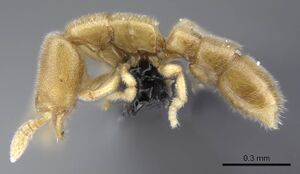 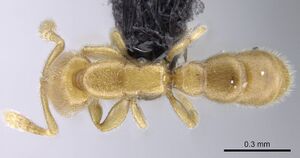 
| |
| Holotype of Prionopelta laurae. Worker. Specimen code casent0046149. Photographer Rick Overson, uploaded by California Academy of Sciences. | Owned by CAS, San Francisco, CA, USA. |
 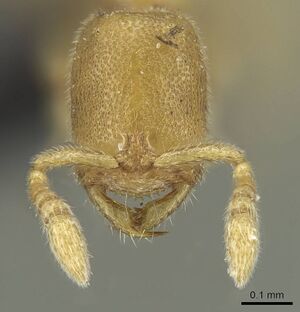
| |
| Paratype of Prionopelta laurae. Worker. Specimen code casent0046151. Photographer Rick Overson, uploaded by California Academy of Sciences. | Owned by CAS, San Francisco, CA, USA. |
 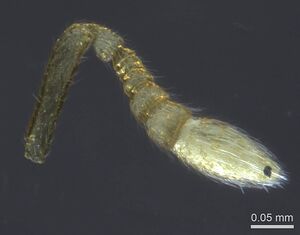
| |
| Worker. Specimen code casent0141731. Photographer Rick Overson, uploaded by California Academy of Sciences. | Owned by CAS, San Francisco, CA, USA. |
Nomenclature
The following information is derived from Barry Bolton's Online Catalogue of the Ants of the World.
- laurae. Prionopelta laurae Overson & Fisher, 2015: 130, fig. 7 (w.) MADAGASCAR.
- Type-material: holotype worker, 9 paratype workers.
- Type-locality: holotype Madagascar: Antsiranana, Parc Nat. de Marojejy, Manantenina River, 28.0 km. NE Andapa, 8.2 km. 333° NNW Manantenina, 14.43667°S, 49.775°E, 450 m., 12.xi.2003, BLF08722, CASENT0046149, rainforest, sifted litter (leaf mold, rotten wood) (B.L. Fisher, et al.); paratypes with same data but CASENT0046140 to -143, CASENT0046147, -148, CASENT0046150, -151, -153.
- Type-depositories: CASC (holotype); BMNH, CASC, MCZC, MHNG, NHMB (paratypes).
- Distribution: Madagascar.
Unless otherwise noted the text for the remainder of this section is reported from the publication that includes the original description.
Description
Worker
(N=16). HL 0.33–0.38 (0.35); HW 0.24–0.27 (0.26); SL 0.16–0.18 (0.17); WL 0.34–0.4 (0.38); PetL 0.09–0.11 (0.1); PetW 0.13–0.15 (0.14); T1W 0.19–0.23 (0.21); CI 67.55–75.64 (72.71); PI 120.18–152.75 (135.44); SI 61.62–69.05 (65.06).
Head much longer than wide with lowest cephalic index on average of all Malagasy Prionopelta (mean CI 72.71); posterior head margin straight in full-face view; cephalic foveae small and very dense, with no space for additional cephalic foveae present; median cephalic band devoid of foveae is long and thin and appears slightly swollen or raised above the surrounding integument, forming a scarlike suture; apical tooth of the mandible over four times the length of third tooth in full-face view; nine antennal segments; eye greatly reduced, appearing as a tiny, dark gray patch; majority of marks on pronotum are densely spaced, tiny punctures; mesonotum and propodeum consisting of tiny shallow foveae; metanotal groove visible dorsally; smallest of the Prionopelta from Malagasy region; body distinctly pale yellow in color.
Type Material
Holotype, pinned worker, MADAGASCAR, Antsiranana, Parc National de Marojejy, Manantenina River, 28.0 km 38° NE Andapa, 8.2 km 333° NNW Manantenina, 14.43667°S, 49.775°E, 450 m, rainforest, sifted litter (leaf mold, rotten wood), collection code: BLF08722, 12.xi.2003 (B.L. Fisher et al.) (California Academy of Sciences: CASENT0046149).
Paratypes, nine pinned workers with same data as holotype (The Natural History Museum: CASENT0046153; CASC: CASENT0046141; CASENT0046142; CASENT0046143; CASENT0046147; CASENT0046151; Museum of Comparative Zoology: CASENT0046150; Musee d'Histoire Naturelle Genève: CASENT0046140; Naturhistorisches Museum, Basel: CASENT0046148).
Etymology
The name of this species is a patronym dedicated to Laura D. Steger for her continual support during the course of this work and her either completely genuine—or expertly feigned—enthusiasm for being endlessly bombarded by information about ants.
